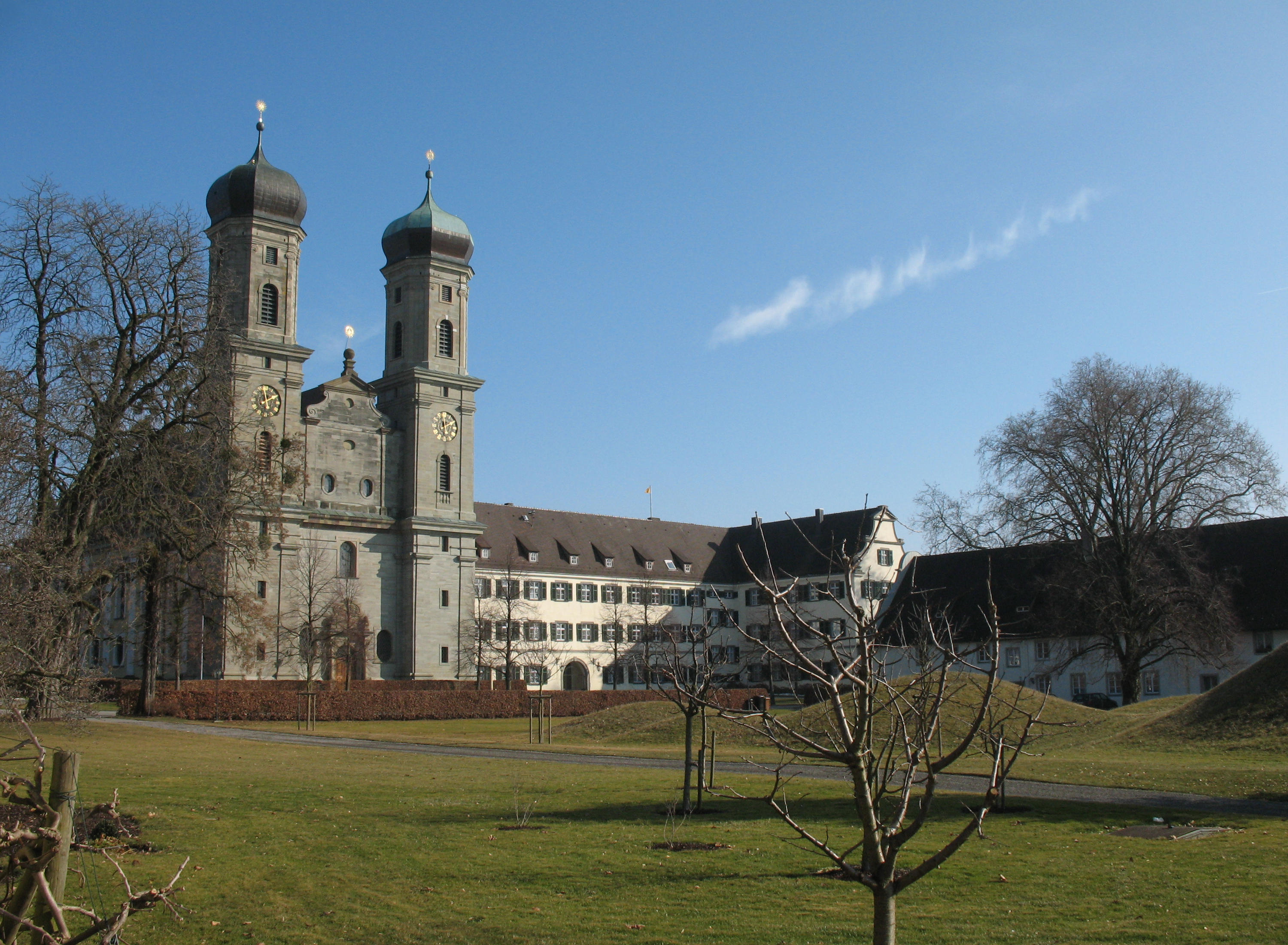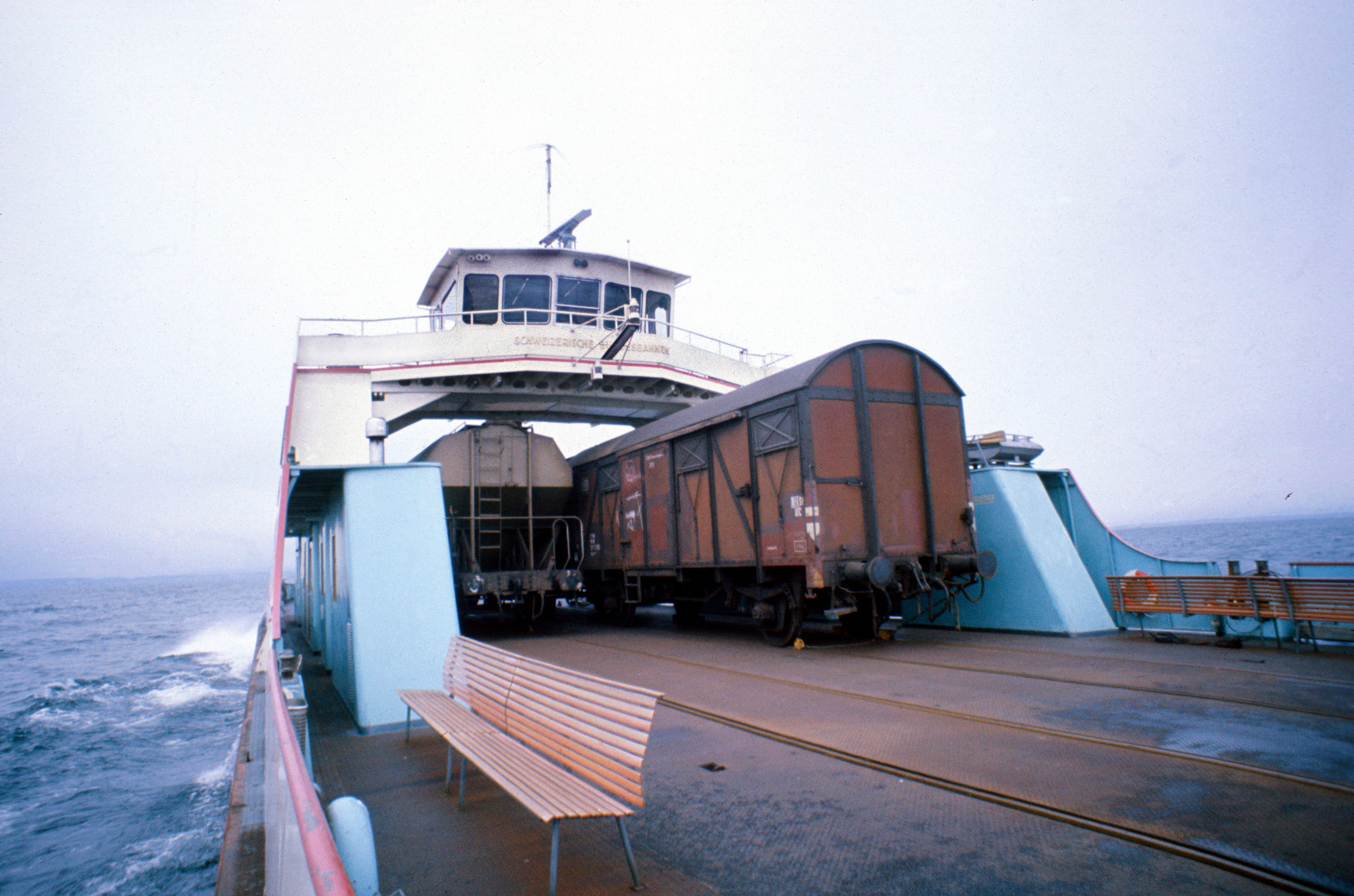|
Romanshorn Railway Station
Romanshorn railway station (german: Bahnhof Romanshorn) is a railway station that serves the municipality of Romanshorn, in the canton of Thurgau, Switzerland. Opened in 1855, the station is owned and operated by SBB-CFF-FFS. It forms the junction between the Winterthur–Romanshorn railway, the Schaffhausen–Rorschach railway and the Romanshorn–Nesslau Neu St. Johann railway. The SBB-CFF-FFS and THURBO operate both long-distance and local traffic to and from the station. These include four St. Gallen S-Bahn lines and an InterCity train to Brig. Layout and connections Romanshorn railway station is situated in Neustrasse, at the eastern edge of the city centre. The station has a side platform with one track ( 1) and two island platforms with two tracks each ( 2–3 and 4–5). On the other side of the tracks is the Romanshorn ferry terminal, for ferries across Lake Constance. History Early years After two years of planning, the station was opened in 1855, together with ... [...More Info...] [...Related Items...] OR: [Wikipedia] [Google] [Baidu] |
Lake Constance
Lake Constance (german: Bodensee, ) refers to three Body of water, bodies of water on the Rhine at the northern foot of the Alps: Upper Lake Constance (''Obersee''), Lower Lake Constance (''Untersee''), and a connecting stretch of the Rhine, called the Seerhein, Lake Rhine (''Seerhein''). These waterbodies lie within the Lake Constance Basin () in the Alpine Foreland through which the Rhine flows. The lake is situated where Germany, Switzerland, and Austria meet. Its shorelines lie in the German states of Baden-Württemberg and Bavaria, the Swiss cantons of Canton of St. Gallen, St. Gallen, Canton of Thurgau, Thurgau, and Canton of Schaffhausen, Schaffhausen, and the Austrian state of Vorarlberg. The actual location of the border Lake_Constance#International_borders, is disputed. The Alpine Rhine forms in its original course the Austro-Swiss border and flows into the lake from the south. The High Rhine flows westbound out of the lake and forms (with the exception of the Canton ... [...More Info...] [...Related Items...] OR: [Wikipedia] [Google] [Baidu] |
Konstanz Station
Konstanz (, , locally: ; also written as Constance in English) is a college town, university city with approximately 83,000 inhabitants located at the western end of Lake Constance in the south of Germany. The city houses the University of Konstanz and was the residence of the Roman Catholic Diocese of Konstanz for more than 1,200 years. Location The city is located in the state of Baden-Württemberg and situated at the banks of Lake Constance (''Bodensee'' in German). The river Rhine, which starts in the Swiss Alps, passes through Lake Constance and leaves it, considerably larger, by flowing under a bridge connecting the two parts of the city. North of the river lies the larger part of the city with residential areas, industrial estates, and the University of Konstanz; while south of the river is the old town, which houses the administrative centre and shopping facilities in addition to the ''Hochschule'' or the ''University of Applied Sciences''. Car ferries provide access acr ... [...More Info...] [...Related Items...] OR: [Wikipedia] [Google] [Baidu] |
Kreuzlingen
Kreuzlingen is a municipality in the district of Kreuzlingen in the canton of Thurgau in north-eastern Switzerland. It is the seat of the district and is the second-largest city of the canton, after Frauenfeld, with a population of about 22,000. Together with the adjoining city of Konstanz just across the border in Germany, Kreuzlingen is part of the largest conurbation on Lake Constance with a population of almost 120,000. History The name of the municipality stems from the Augustinian monastery ''Crucelin'', later Kreuzlingen Abbey. It was founded in 1125 by the Bishop of Constance Ulrich I. In the Swabian War and the 30 Years' War after the siege of Constance by Swedish troops, the Augustinian monastery was burned down by the people of Constance, who blamed the monks for having supported the enemy. In 1650, the monastery was rebuilt in its present location. With secularization in 1848, the buildings became a teachers' school. The chapel became a Catholic Church. The area ... [...More Info...] [...Related Items...] OR: [Wikipedia] [Google] [Baidu] |
Bregenz
Bregenz (; gsw, label= Vorarlbergian, Breagaz ) is the capital of Vorarlberg, the westernmost state of Austria. The city lies on the east and southeast shores of Lake Constance, the third-largest freshwater lake in Central Europe, between Switzerland in the west and Germany in the northwest. Bregenz is located on a plateau falling in a series of terraces to the lake at the foot of Pfänder mountain. It is a junction of the arterial roads from the Rhine valley to the German Alpine foothills, with cruise ship services on Lake Constance. It is famous for the annual summer music festival ''Bregenzer Festspiele'', as well as the dance festival ''Bregenzer Spring''. History The first settlements date from 1500 BC. The Brigantii are mentioned by Strabo as a Celtic sub-tribe in this region of the Alps. In the 5th century BC, the Celts settled at Brigantion, which became one of their most heavily fortified locations. After a series of battles in 15 BC, the Romans conquered Brigantion ... [...More Info...] [...Related Items...] OR: [Wikipedia] [Google] [Baidu] |
Lindau
Lindau (german: Lindau (Bodensee), ''Lindau am Bodensee''; ; Low Alemannic German, Low Alemannic: ''Lindou'') is a major Town#Germany, town and Lindau (island), island on the eastern side of Lake Constance (''Bodensee'' in German) in Bavaria, Germany. It is the capital of the county (''Landkreis'') of Lindau (district), Lindau, Bavaria and is near the borders of the Austrian state of Vorarlberg and the Switzerland, Swiss cantons of Canton of St. Gallen, St. Gallen and Canton of Thurgau, Thurgau. The coat of arms of Lindau town is a linden tree, referring to the supposed origin of the town's name (''Linde'' means linden tree in German). The historic town of Lindau is located on the island of the same name which is connected with the mainland by a road bridge and a railway dam leading to Lindau Hauptbahnhof, Lindau station. History The first use of the name Lindau was documented in 882 by a monk from St. Gallen, stating that Adalbert (Raetia, count of Raetia) had founded a nun ... [...More Info...] [...Related Items...] OR: [Wikipedia] [Google] [Baidu] |
Friedrichshafen
Friedrichshafen ( or ; Low Alemannic: ''Hafe'' or ''Fridrichshafe'') is a city on the northern shoreline of Lake Constance (the ''Bodensee'') in Southern Germany, near the borders of both Switzerland and Austria. It is the district capital (''Kreisstadt'') of the Bodensee district in the federal state of Baden-Württemberg. Friedrichshafen has a population of about 58,000. History 19th and early 20th century Friedrichshafen was established in 1811 as part of the new Kingdom of Württemberg, an ally of France during the Napoleonic Wars. It was named for King Frederick I of Württemberg, who privileged it as a free port and transshipment point for the kingdom's Swiss trade. Friedrichshafen was created from the former city of Buchhorn, whose coat of arms it adopted. The new city also incorporated the former village of Hofen, whose monastery was refurbished to serve as the summer residence of the Württemberger kings. King William I continued improving the city, including the purch ... [...More Info...] [...Related Items...] OR: [Wikipedia] [Google] [Baidu] |
Lake Constance Train Ferry
The Lake Constance train ferries (''Bodensee-Trajekte'') were train ferries that were set up in the 19th century by railway companies to transport rail freight wagons across Lake Constance (''Bodensee'') between the five states located around the lake at the time. In the heyday of the railways, they were of great importance, especially for freight traffic. Early History Traffic parallel to the shore initially dominated shipping on Lake Constance. It was not until railways reached some port cities that the importance of the connections across Lake Constance increased, especially for grain traffic. Starting from 1824, steamboats were operated by different companies, rising to 2,874 in 1874. * The first German railway company to reach Lake Constance was the Royal Württemberg State Railways (''Königlich Württembergische Staats-Eisenbahnen'') with its Southern Railway (''Südbahn'') in Friedrichshafen. The railway line from Friedrichshafen to Ravensburg was opened on 8 November 18 ... [...More Info...] [...Related Items...] OR: [Wikipedia] [Google] [Baidu] |
Swiss Northeastern Railway
The Swiss Northeastern Railway (''Schweizerische Nordostbahn''; NOB) was an early railway company in Switzerland. It also operated shipping on Lake Constance (''Bodensee'') and Lake Zürich. Until the merger of the Western Swiss Railways into the Jura–Simplon Railway (JS) in 1890/91, it was the largest Swiss railway company. History The Swiss Northeast Railway was created on 1 July 1853 by the merger of the Swiss Northern Railway (''Schweizerische Nordbahn''—SNB— informally known as the ''Spanisch Brötli, Spanisch-Brötli-Bahn''), and the Zürich-Lake Constance Railway (''Zürich-Bodenseebahn''). The originally planned continuation of the Northern Railway from Baden, Switzerland, Baden to Basel initially failed due to the different interests of the cantons of Canton of Zürich, Zürich, Canton of Aargau, Aargau and Canton of Basel, Basel. The main initiator of the merger was the Zürich-based businessman Alfred Escher, who previously headed the Zürich-Lake Constance R ... [...More Info...] [...Related Items...] OR: [Wikipedia] [Google] [Baidu] |
Station Building
A station building, also known as a head house, is the main building of a passenger railway station. It is typically used principally to provide services to passengers. A station building is a component of a station, which can include tracks, platforms, an overpass or underpass, and a train shed. Normally, a station building will be of adequate size for the type of service that is to be performed. It may range from a simple single-storey building with limited services to passengers to a large building with many indoor spaces providing many services. Some station buildings are of monumental proportions and styles. Both in the past and in recent times, especially when constructed for a modern high-speed rail network, a station building may even be a true masterpiece of architecture. A typical railway station building will have a side entrance hall off the road or square where the station is located. Near the entrance will be a ticket counter, ticket machines, or both. There will ... [...More Info...] [...Related Items...] OR: [Wikipedia] [Google] [Baidu] |






